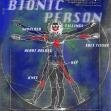 Recently at Experimental Biology 2006 some of the leading scientists in the rapidly expanding field of bionics explain how much of what was once fiction is today at least partial reality – including electronically-powered legs, arms, and eyes like those given TV’s Six Million Dollar Man 30-plus years ago.
Recently at Experimental Biology 2006 some of the leading scientists in the rapidly expanding field of bionics explain how much of what was once fiction is today at least partial reality – including electronically-powered legs, arms, and eyes like those given TV’s Six Million Dollar Man 30-plus years ago.The symposium on “The $6 Billion (Hu)Man” was part of the scientific program at the Experimental Biology 2006 meeting. Bionics, a word that merges biology with electronics, means replacing or enhancing anatomical structures or physiological processes with electronic or mechanical components Unlike prostheses, the bionic implant actually mimics the original function, sometimes surpassing the power of the original organ or other body part. Bionics takes place at the interface between bioengineering and anatomy.
Dr. William Craelius, Rutgers University, created the first multi-finger prosthesis, combining new understanding of musculoskeletal signaling with advances in human-to-machine communication. In recent years, prosthetic limbs have transformed from the unwieldy designs of the last century into more life-like limb substitutes that give users a more intuitive feel for their adopted limb. The bionic hand system (Dextra) produced by Dr. Craelius and his colleagues uses existing nerve pathways to control individual computer-driven mechanical fingers. Dextra consists of a standard plastic socket and silicone sensor sleeve that encases an amputee’s limb below the elbow. After a brief training period, operating the fingers is biomimetic, that is, it is done by normal volitional thinking, as if the user were commanding his natural fingers.
In Dr. Scott Delp’s Neuromuscular Biomechanics Laboratory at Stanford, digital humans walk across the computer screen, their visible musculoskeletal system revealing the complex interplay of muscles, bones, momentum and gravity that makes up human movement. A few alterations to the computer program that controls the form and function of these mechanisms, and the movements of the previously healthy, agile human on the screen change into those caused by neuromuscular disorders such as stroke, osteoarthritis, or Parkinson’s.
Dr. Homayoon Kazerooni, University of California, Berkeley, is the creator of BLEEX, a wearable robotic system that turns its wearer into a man or woman of incredible strength, able to carry up to 200 pounds with no more effort or strain than it would take to carry 10 pounds. Dr. Kazerooni started his work by understanding the human gait. Then, through the design of a novel actuation system, a network of sensors, a pair of computer controlled strap-on robotic legs, and an intelligent algorithm, he created the BLEEX to follow the wearer’s gait faithfully while carrying major loads. As the wearer walks and runs normally on ascending and descending slopes and stairs, the embedded sensors and computers in the robotic legs function like an extension of his or her own nervous system, gathering information on the direction being moved and continually redistributing the weight to make it feel like a barely perceptible burden.
Dr. Timothy Marler describes SantosTM, a new kind of complete whole-body virtual (computer-based) human model developed at the University of Iowa’s Virtual Soldier Research laboratory. Santos TM combines a highly realistic appearance, real-time simulations, and a relatively complex musculoskeletal structure. Because he will think, move, and act like a real human, he provides both an unique tool to scientists studying the human body and feedback to engineers who are designing and improving products. Unlike virtual mannequins, Santos actually predicts human motion and behavior based on human performance measures, such as energy, joint torque, or discomfort.

